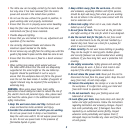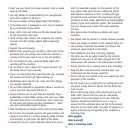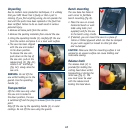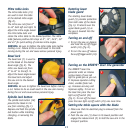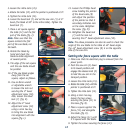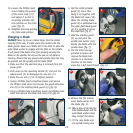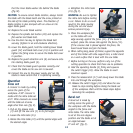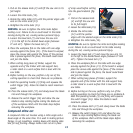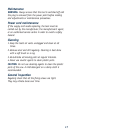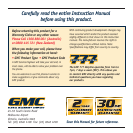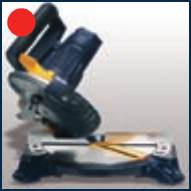
15
1. Pull on the release knob (2) and lift the saw arm to its
full height.
2. Loosen the mitre locks (15).
3. Rotate the mitre table (12) until the pointer aligns with
zero on the mitre scale (13).
4. Retighten the mitre locks (15).
WARNING. Be sure to tighten the mitre locks before
making a cut. Failure to do so could result in the table
moving during the cut, causing serious personal injury.
5. Loosen the bevel lock (7) and move the saw arm
(1) to the left to the desired bevel angle (between
0º and 45º). Tighten the bevel lock (7).
6. Place the workpiece flat on the table with one edge
securely against the fence (11). If the board is warped,
place the convex side against the fence. If the concave
side is placed against the fence, the board could break
and jam the blade.
7. When cutting long pieces of timber, support the
opposite end of the timber with side support bars,
a roller stand or a work surface that is level with the
saw table.
8. Before turning on the saw, perform a dry run of the
cutting operation to check that there are no problems.
9. Hold the operating handle (3) firmly and squeeze the
switch trigger (16). Allow the blade to reach maximum
speed.
10. Press the release latch (17) and slowly lower the blade
into and through the workpiece.
11. Release the switch trigger (16) and allow the saw
blade to stop rotating before raising the blade out
of the workpiece. Wait until the blade stops before
removing the workpiece.
Compound mitre cut
A compound mitre cut involves using a mitre angle and a
bevel angle at the same time. It is used in making picture
frames, to cut mouldings, making boxes with sloping sides
and for roof framing. Always make a test cut on a piece
of scrap wood before cutting
into the good material (fig.
a).
1. Pull on the release knob
(2) and lift the saw arm
to its full height.
2. Loosen the mitre locks (15).
3. Rotate the mitre table
(12) until the pointer
aligns with the desired angle on the mitre scale (13).
4. Retighten the mitre locks (15).
WARNING. Be sure to tighten the mitre lock before making
a cut. Failure to do so could result in the table moving
during the cut, causing serious personal injury.
5. Loosen the bevel lock (7) and move the saw arm (1)
to the left to the desired bevel angle (between 0º and
45º). Tighten the bevel lock (7).
6. Place the workpiece flat on the table with one edge
securely against the fence (11). If the board is warped,
place the convex side against the fence. If the concave
side is placed against the fence, the board could break
and jam the blade.
7. When cutting long pieces of timber, support the
opposite end of the timber with the side support bars,
a roller stand or a work surface that is level with the
saw table.
8. Before turning on the saw, perform a dry run of the
cutting operation to check that there are no problems.9.
Hold the operating handle (3) and firmly and squeeze
the switch trigger (16). Allow the blade to reach
maximum speed.
10. Press the release latch (17) and slowly lower the blade
into and through the workpiece.
11. Release the switch trigger (16) and allow the saw
blade to stop rotating before raising the blade out
of the workpiece. Wait until the blade stops before
removing the workpiece.
a



